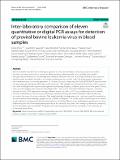| dc.contributor.author | Pluta, Aneta | |
| dc.contributor.author | Jaworski, Juan P. | |
| dc.contributor.author | Droscha, Casey | |
| dc.contributor.author | VanderWeele, Sophie | |
| dc.contributor.author | Taxis, Tasia M. | |
| dc.contributor.author | Valas, Stephen | |
| dc.contributor.author | Brnić, Dragan | |
| dc.contributor.author | Jungić, Andreja | |
| dc.contributor.author | Ruano, María J. | |
| dc.contributor.author | Sánchez, Azucena | |
| dc.contributor.author | Murakami, Kenji | |
| dc.contributor.author | Nakamura, Kurumi | |
| dc.contributor.author | Puentes, Rodrigo | |
| dc.contributor.author | De Brun, MLaureana | |
| dc.date.accessioned | 2024-09-03T19:54:03Z | |
| dc.date.available | 2024-09-03T19:54:03Z | |
| dc.date.issued | 2024-08-26 | |
| dc.identifier.uri | https://hdl.handle.net/1721.1/156536 | |
| dc.description.abstract | Bovine leukemia virus (BLV) is the etiological agent of enzootic bovine leukosis and causes a persistent infection that can leave cattle with no symptoms. Many countries have been able to successfully eradicate BLV through improved detection and management methods. However, with the increasing novel molecular detection methods there have been few efforts to standardize these results at global scale. This study aimed to determine the interlaboratory accuracy and agreement of 11 molecular tests in detecting BLV. Each qPCR/ddPCR method varied by target gene, primer design, DNA input and chemistries. DNA samples were extracted from blood of BLV-seropositive cattle and lyophilized to grant a better preservation during shipping to all participants around the globe. Twenty nine out of 44 samples were correctly identified by the 11 labs and all methods exhibited a diagnostic sensitivity between 74 and 100%. Agreement amongst different assays was linked to BLV copy numbers present in samples and the characteristics of each assay (i.e., BLV target sequence). Finally, the mean correlation value for all assays was within the range of strong correlation. This study highlights the importance of continuous need for standardization and harmonization amongst assays and the different participants. The results underscore the need of an international calibrator to estimate the efficiency (standard curve) of the different assays and improve quantitation accuracy. Additionally, this will inform future participants about the variability associated with emerging chemistries, methods, and technologies used to study BLV. Altogether, by improving tests performance worldwide it will positively aid in the eradication efforts. | en_US |
| dc.publisher | BioMed Central | en_US |
| dc.relation.isversionof | https://doi.org/10.1186/s12917-024-04228-z | en_US |
| dc.rights | Creative Commons Attribution | en_US |
| dc.rights.uri | https://creativecommons.org/licenses/by/4.0/ | en_US |
| dc.source | BioMed Central | en_US |
| dc.title | Inter-laboratory comparison of eleven quantitative or digital PCR assays for detection of proviral bovine leukemia virus in blood samples | en_US |
| dc.type | Article | en_US |
| dc.identifier.citation | Pluta, A., Jaworski, J.P., Droscha, C. et al. Inter-laboratory comparison of eleven quantitative or digital PCR assays for detection of proviral bovine leukemia virus in blood samples. BMC Vet Res 20, 381 (2024). | en_US |
| dc.relation.journal | BMC Veterinary Research | en_US |
| dc.identifier.mitlicense | PUBLISHER_CC | |
| dc.eprint.version | Final published version | en_US |
| dc.type.uri | http://purl.org/eprint/type/JournalArticle | en_US |
| eprint.status | http://purl.org/eprint/status/PeerReviewed | en_US |
| dc.date.updated | 2024-09-01T03:20:51Z | |
| dc.language.rfc3066 | en | |
| dc.rights.holder | The Author(s) | |
| dspace.date.submission | 2024-09-01T03:20:51Z | |
| mit.journal.volume | 20 | en_US |
| mit.license | PUBLISHER_CC | |
| mit.metadata.status | Authority Work and Publication Information Needed | en_US |
